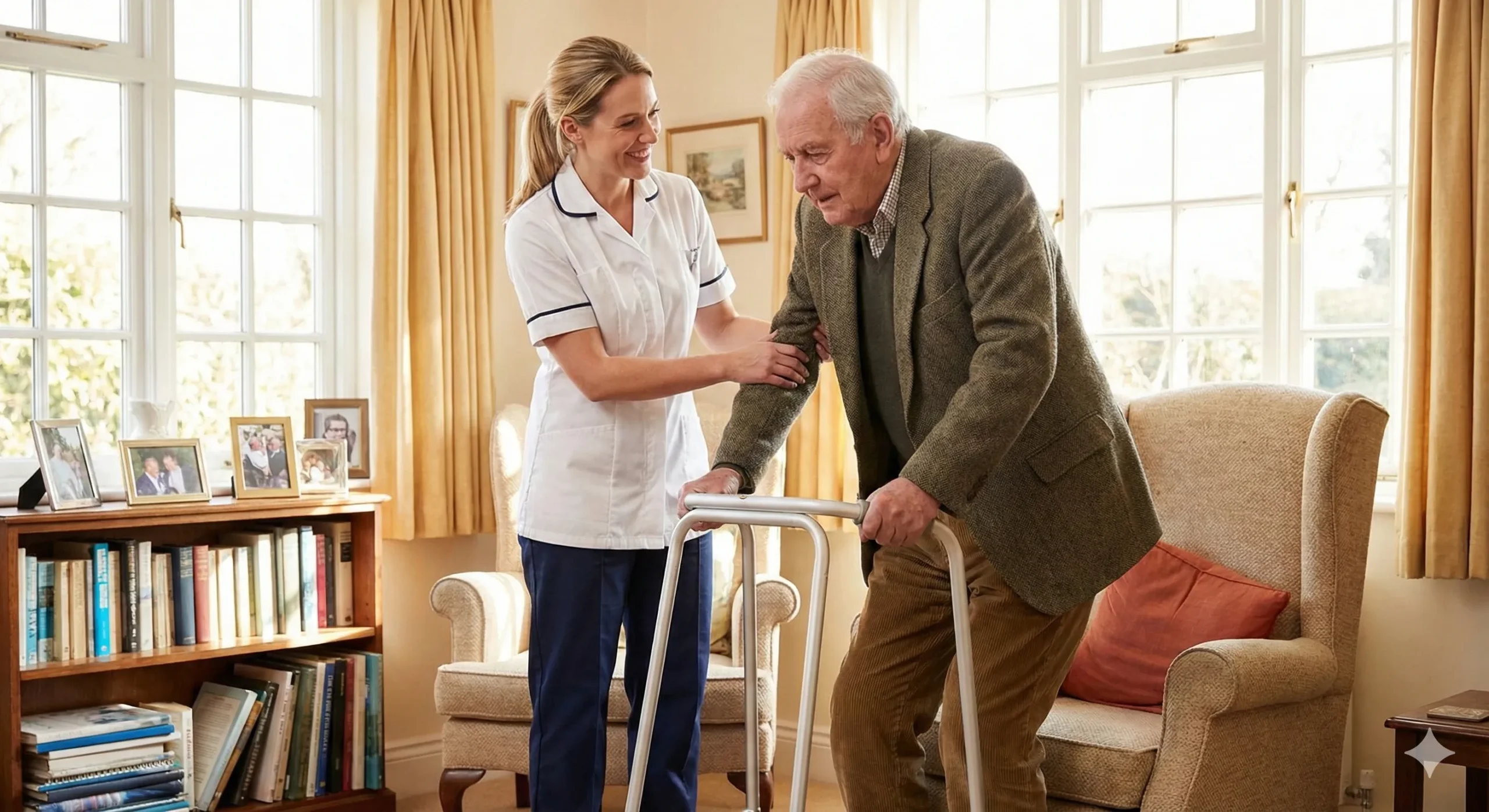As we grow older, recovering from an illness, managing a long-term condition, or simply noticing that daily tasks feel more difficult are very common experiences. This guide explains how physiotherapy for the elderly at home provides a supportive, effective way to rebuild strength, confidence, and independence in the comfort of your own surroundings.
Key Takeaways
- Home physiotherapy services bring expert care to you, eliminating the stress of travel and waiting rooms.
- A personalised treatment plan targets your specific goals, from walking to the shops to climbing stairs safely.
- Regular input helps reduce the risk of falls and improves overall quality of life.
In This Article
What is Home Physiotherapy?
Home physiotherapy (often called domiciliary care) is simply when a chartered physiotherapist visits you to provide assessment and rehabilitation in your own house or care home. The key advantage is context.
By seeing exactly how you move around your furniture, navigate your specific stairs, and use your own kitchen, a therapist can tailor advice and exercises that are perfectly matched to your real-life needs. This is specialist elderly care designed to make your daily life easier and safer.
Why Choose Home Visits Over a Clinic?
While clinics have their place, physiotherapy for the elderly at home offers distinct advantages. For many older adults, the physical effort of travelling to a clinic, finding parking, and sitting in a waiting room can leave them too fatigued to benefit fully from the session.
By bringing expert care directly to you, we remove that barrier. Here are three key benefits:
- Real-World Rehabilitation: We don’t just practice exercises in a gym; we practice them where you live. We help you master getting out of your favourite chair or walking to the garden gate.
- Comfort and Privacy: Recovering from a fall or surgery can feel vulnerable. Treatment in the comfort of your own home allows you to relax, often leading to better results.
- Bridging the Gap: With high demand on the NHS, many people face long waiting lists for community services. Private home physiotherapy ensures you don’t lose valuable recovery time.

Who Can Benefit From Home Physiotherapy?
Elderly physiotherapy is helpful in many different situations. It is particularly valuable for:
- Post-Hospital Recovery: For those returning home after surgery (such as a hip or knee replacement) or a long illness, it provides a crucial bridge to regaining stamina.
- Falls Prevention: If you have had a fall or feel unsteady, a therapist can design a targeted falls prevention programme to improve balance and reduce the risk of falls.
- Neurological Conditions: People living with long-term conditions like Stroke or Parkinson’s disease benefit immensely from regular therapy to maintain function.
- General Mobility: If you have simply noticed a decline in ability, a course of elderly rehabilitation at home can help you regain strength and confidence.
What to Expect: Your Treatment Plan
A good physiotherapy service follows a supportive process. Your first visit involves a thorough assessment where the therapist listens to your medical history and observes your mobility. This is a collaborative process.
Together, you will set realistic goals. Do you want to walk to the post box? Or perhaps feel safer getting in and out of the bath? Based on these goals, the therapist creates a personalised treatment plan.
This plan typically includes:
- Strength Training: Gentle resistance exercises to combat muscle loss.
- Balance Work: Drills to improve stability and confidence.
- Practical Strategies: Advice on equipment or small home adaptations to make life easier.
Recommended At-Home Exercises
Safety First: The following exercises are for general guidance only. Please consult with a qualified therapist to ensure they are appropriate for your specific condition. Always work within a safe range of motion.
1. Sit to Stand
From a sturdy, non-moveable chair, lean forward and push through your feet to stand up straight. Try not to use your hands if it is safe to do so. Slowly lower yourself back down with control. This is excellent for building leg strength for everyday movements.
Reps & Sets: 5–10 reps, 2–3 sets.
2. Heel Raises
Stand tall while holding onto a stable surface like a kitchen worktop for support. Slowly rise up onto your tiptoes, hold for a moment, and then lower your heels back down with control. This helps to strengthen your calf muscles, which are important for walking.
Reps & Sets: 8–12 reps, 2–3 sets.
3. Marching on the Spot
While holding onto your support, lift one knee up towards your chest to a comfortable height, then lower it and repeat with the other leg. This gentle exercise is great for improving balance and mobility.
Reps & Sets: 10-15 marches per leg, 2 sets.
The information in this article is intended for general educational purposes only and should not be considered a substitute for a personalised assessment from a qualified healthcare professional. Please consult with a therapist for advice tailored to your specific condition.
Final Thoughts
Home physiotherapy is a partnership between you and your therapist, designed to help you live as fully and independently as possible. By bringing expert care directly to you, it offers a practical, personalised, and reassuring path towards improved mobility, greater confidence, and a better quality of life.
